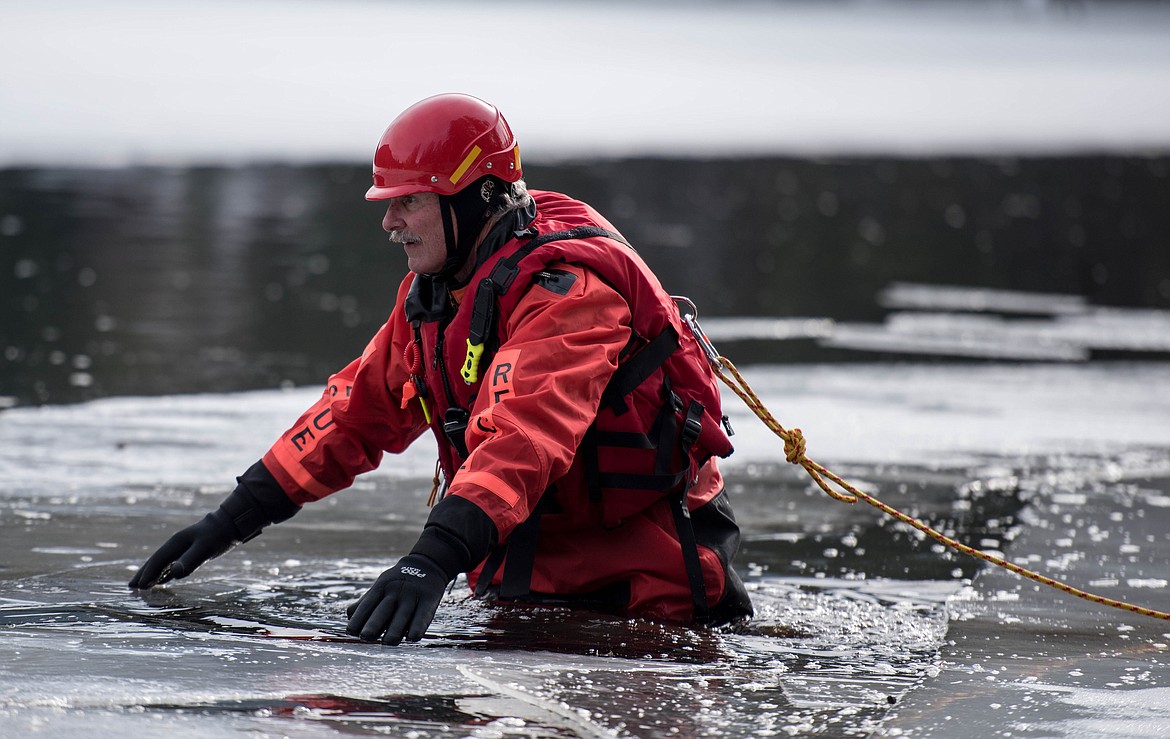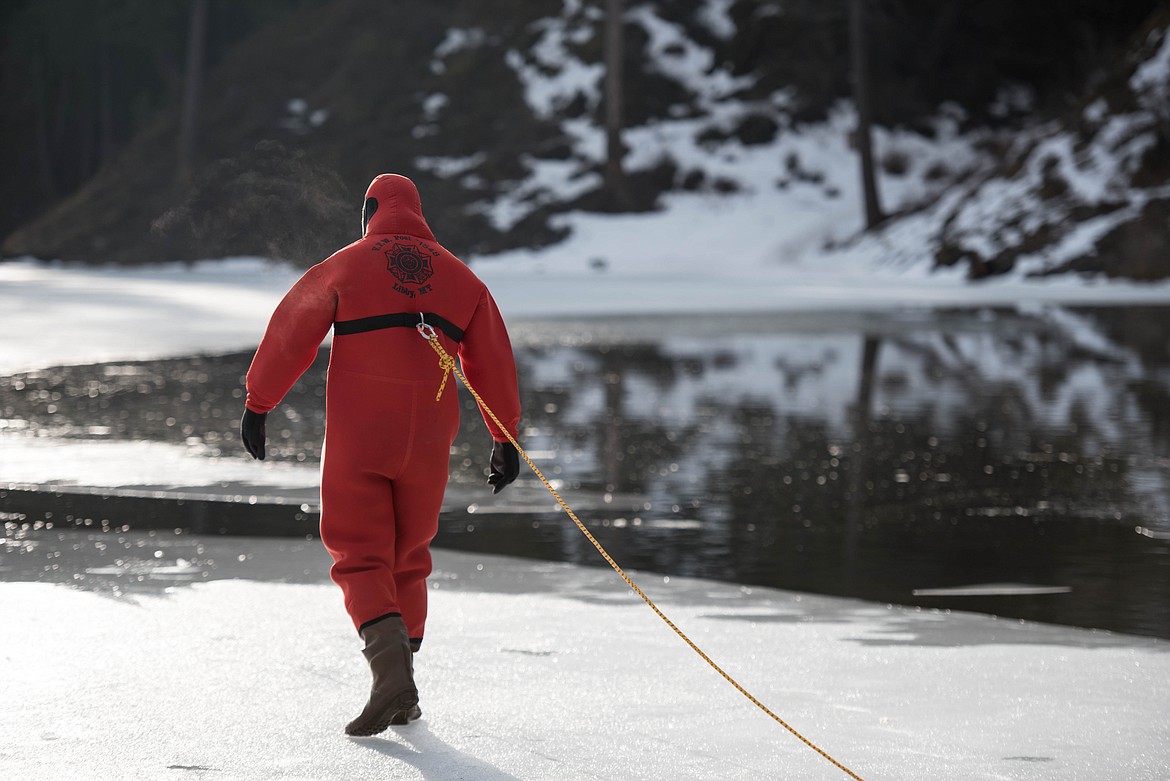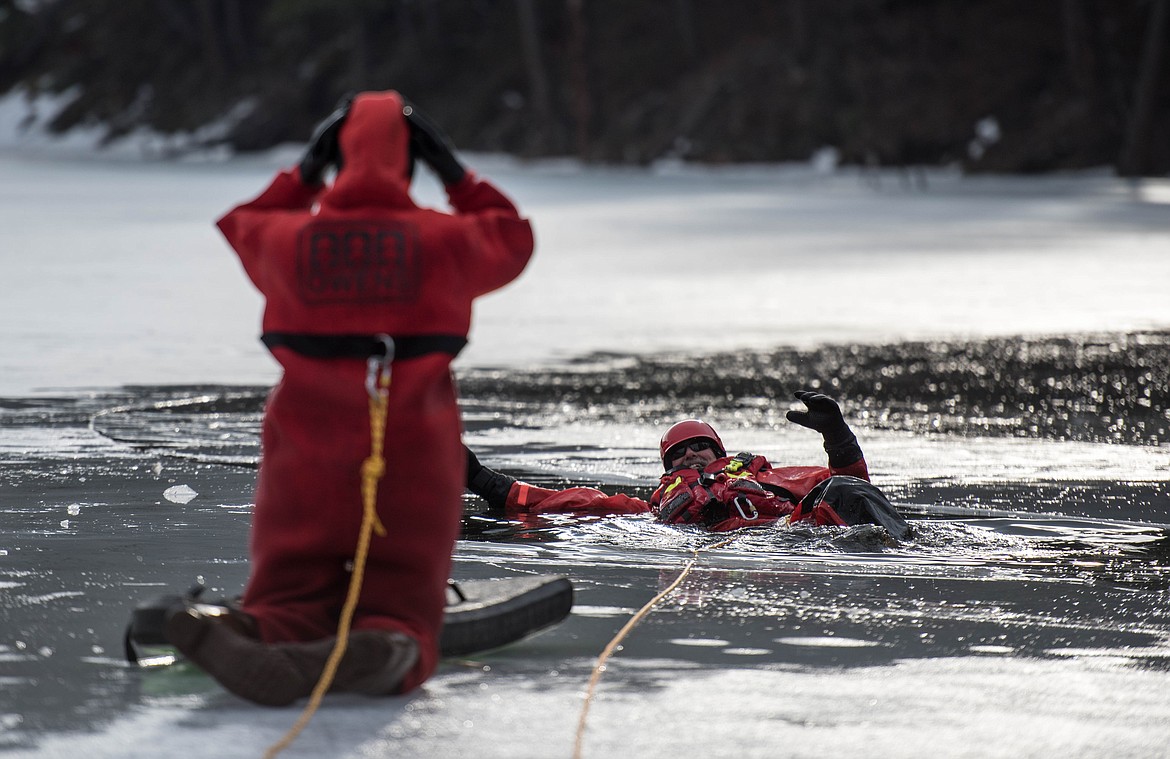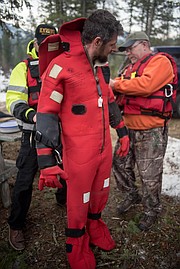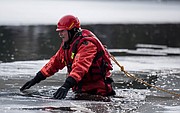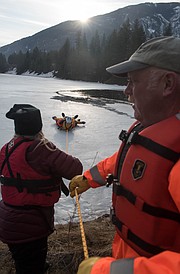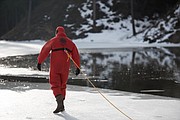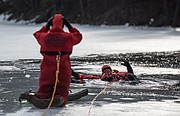Prepared for the worst Search and rescuers practice saving victims from icy water
Luke Hollister Western News | Hagadone News Network | UPDATED 6 years, 8 months AGO
The sun had just started to peek over the mountains above Throop Lake and it was cold, but not frozen enough to keep from falling in.
Jon Obst, a search and rescue veteran of 20 years, was looking for a spot to jump in.
Covered in bright-colored protective gear and hooked to a rope, he slowly shuffled across the lake.
About 40 feet out, the lake cracked open, immersing Obst in the icy water.
“Falling in? It’s weird at first,” he said. Obst is a former president of David Thompson Search and Rescue. He still comes to the trainings.
Every year, people out in the elements accidentally fall through the ice, he said. David Thompson Search and Rescue team members will “definitely respond anytime, anyplace.”
The crew has to be ready for any scenario, he said.
Obst helped them practice pulling people out of frozen water during a seasonal training Saturday.
In the back of his truck sits a full-body rescue suit, always ready. That way, he can respond as quickly as possible if he gets a call.
Though Obst is a former member of David Thompson, he considers himself an honorary part of the team.
The crew trains for the worst situations, he said. If something goes wrong, they know what to do and how to focus their adrenaline.
Terry Crooks, a unit leader with David Thompson, said he wants people in the community to come back home safely.
All the rescuers work together. There is no individual person who does it all, he said.
The team spends time training so when they go into “rescue mode” it just becomes autopilot, he said. If anyone needs to be rescued, then their years of training will kick in.
Crooks has been working with search and rescue in Lincoln county for 35 years.
“Everyone who is in this harsh environment that we live in, can or will be getting in trouble,” he said.
Education is the best component of search and rescue, he said. People need to be aware of thin ice and how quickly — in 30 seconds — hypothermia can render someone immobile.
“Even though we train for it, we do not want to get a call that somebody’s gone through the ice,” he said.
When someone does not make it home, it hurts the hearts of everyone in the community, he said. Things can go sideways and people out in the elements need to be responsible.
“It’s unfortunate that people get themselves into hardships but that’s the reality of life,” he said. “Even the best can get in trouble out there,” and situational awareness is very important.
Potential victims get the idea that they will be able to stay afloat if they fall in, but their body will cool down extremely fast, he said. People are basically warm-water creatures.
“Time is critical,” he said. Both the time it takes for a rescue team to arrive and the seconds it takes for hypothermia to set in.
Crooks, like the rest of the rescue staff, took turns pulling people out of the ice. He crawled out onto the lake, belly down, arms out, slowly moving forward.
The ice rescue suits are heavy, thick, stiff and hard to walk in, especially on ice.
Norm Branch, an ice rescue teacher apart from the rescue team, sat out in the lake, observing the trainees.
“It’s not really as easy as it looks, crawling on the ice” he said.
Climbing out of a frozen lake is difficult in deep water, he said. Saving a victim is especially hard when the ice is not thick enough to hold a person and too thin to walk on.
Rescuers sometimes have to pound through layers of ice to save a victim, he said. It might be sunny out now, but being in an ice rescue is very tiring and it can get cold.
Branch enjoys helping his crew train and cares a lot about his work.
“The community has been there for me before, so I feel like I’m just giving back,” he said.
ARTICLES BY LUKE HOLLISTER WESTERN NEWS
Interim Kootenai supervisor promotes forest resiliency
Kootenai National Forest’s temporary supervisor is on track to sell roughly 78 million board feet of timber this season, with plans to salvage burned timber from last year’s fires, but mostly, she wants to get back to cutting green trees.
Libby deer infected with wasting disease
Montana Fish, Wildlife and Parks officials recently found a white-tailed doe infected with Chronic Wasting Disease for the first time west of the Continental Divide, and the animal was found within the Libby city limits, according to a press release from the state agency.
Stimson Lumber reps discuss forest management
Stimson Lumber Co. representatives showed plans for a conservation easement and dispelled rumors of having a new mill in Libby at a meeting last week with the Society of American Foresters.



